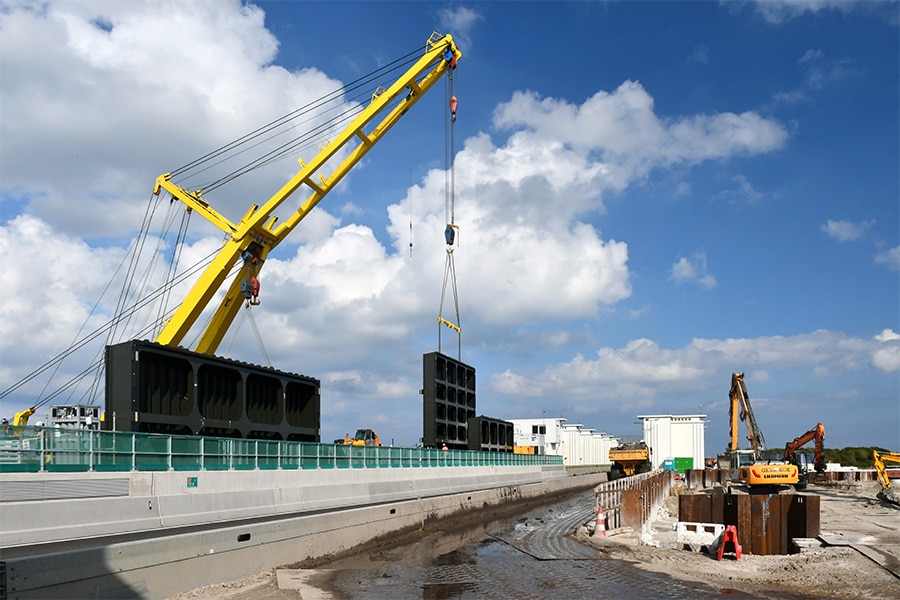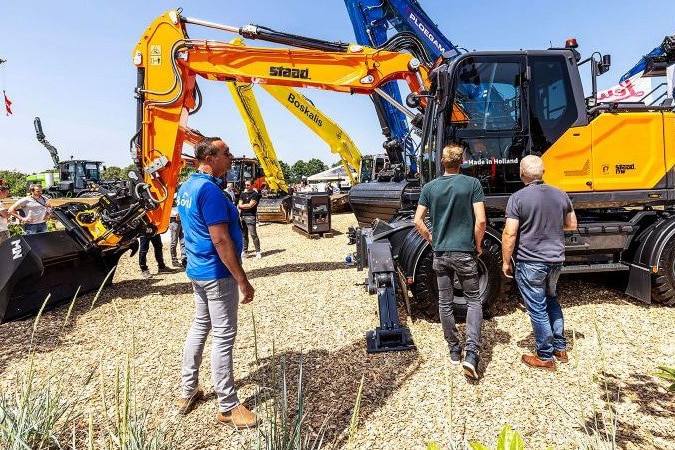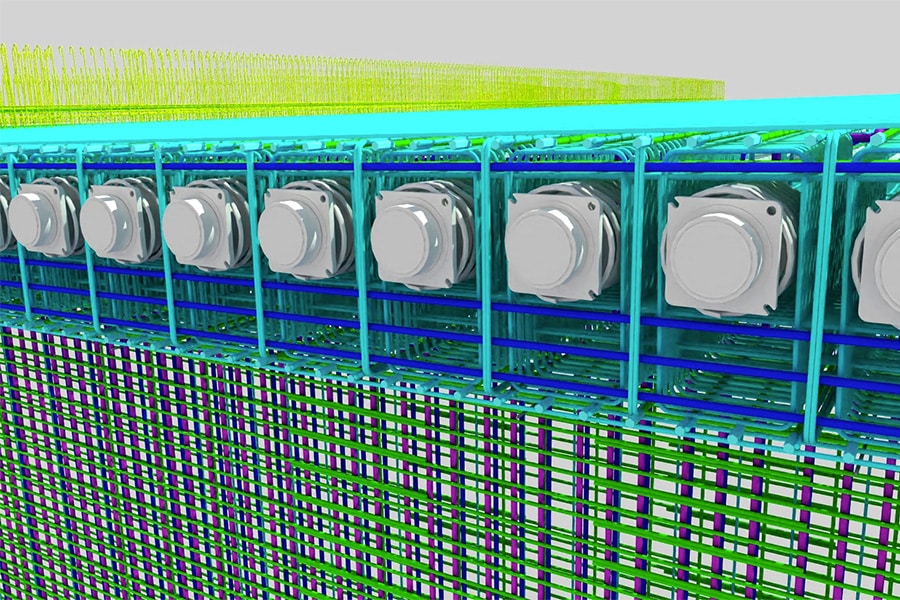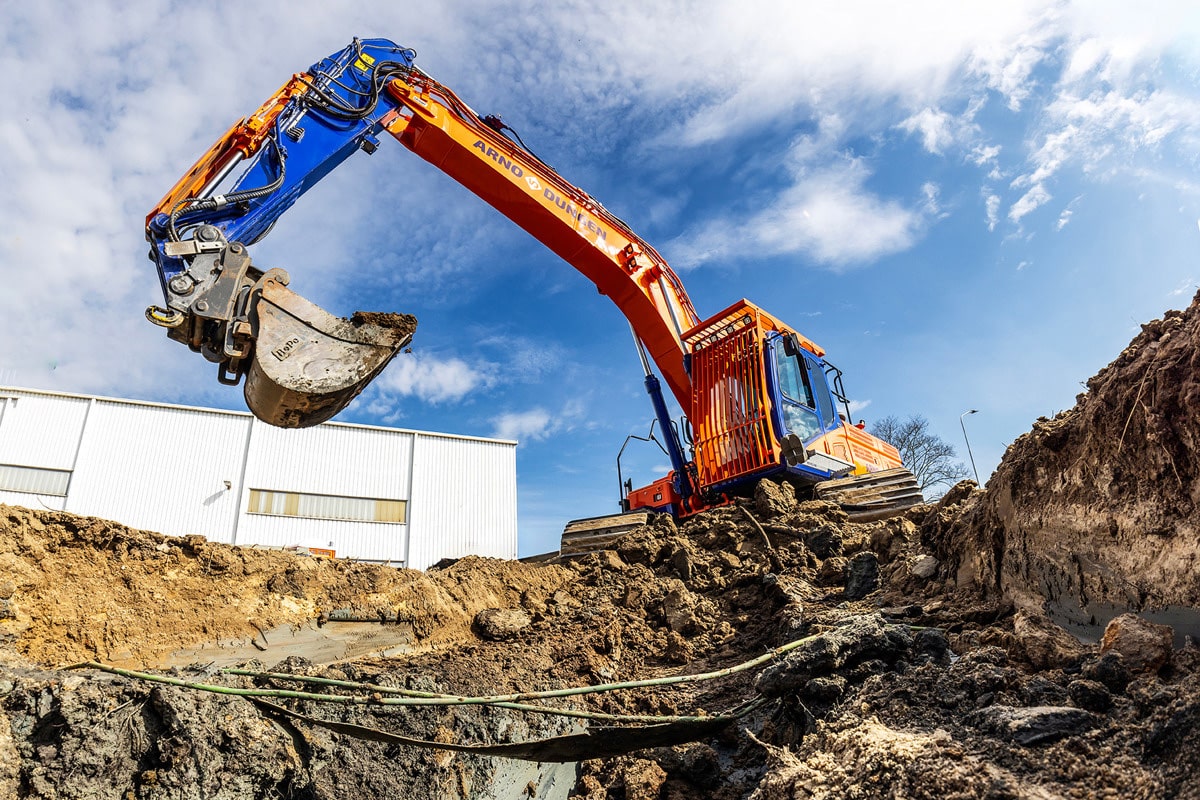
Climate resilient and water-robust approach to sewer system Eindhoven street in Strijp in the context of climate adaptation
In order to be better prepared for more extreme showers in the city in the future, Eindhoven is carrying out a number of projects in which the old sewer system will be converted into a separate system with a dirty water sewer and a rainwater sewer. At the same time, a water storage facility is being built in this street that can store up to 60 mm of rainwater at peak load.
Eindhoven explicitly chose Rockflow (part of the ROCKWOOL Group) for the project in Strijp in order to compare this stone wool water buffer system with other underground solutions already in use for water storage in the city. This will allow us to experimentally determine which solution is most suitable for which situation for future projects.
In the context of the climate adaptation every municipality in the Netherlands is required to map which areas of the city are at risk when it comes to flooding and heat stress. This is necessary to make society less vulnerable to climate disruption. That the climate is changing is now on everyone's mind. That is why more and more municipalities are paying attention to it, especially after one climate record after another has been broken over the past three years, with the driest summer in 2018 and the heaviest downpours ever in 2019. Statistics from KNMI show that in 2019, the number of days with extreme rainfall (>50 mm of precipitation per day) increased by 60% since the 1960s. You won't get the water problem solved just by applying measures on public land. Ecologically, making urban areas water-robust and climate-proof depends on a broader approach than applying technical solutions locally.
Leaders
Eindhoven is one of the frontrunners in the Netherlands when it comes to water-robust and climate-resistant urban living and working environments. Frank van Ekert, urban water management consultant with the municipality of Eindhoven, explains that Eindhoven has approximately 1,300 km of sewer pipes. Eindhoven has a complex sewage system, which is fully interconnected. "Most sewer pipes last 60 to 80 years and then need renovation," he explains. "Based on inspections, about 6 km are renovated every year. Meanwhile, 500 km of sewers have been extended or replaced by a separate sewer system with a dirty water and rainwater pipe." The sewers in the Netherlands contain overflows that discharge excess water into surface water during peak rains, which eventually ends up in natural areas. In the Netherlands, surface water, meaning the water in streams, ponds, canals and rivers is relatively more polluted than in other European countries. Eindhoven has 29 overflows.

Holding where it falls
With the climate changing dramatically and peak rainfall becoming increasingly severe, the city's sewers can no longer handle all this water, causing flooding. In addition, the city is highly densified, with more pavement, more residents and businesses, and more connections to the sewer system. "Meanwhile, we are working on policy to reduce the risk of flooding in projects in private space," says Van Ekert. "Since 2019, Eindhoven has required in new projects in private space that water storage be integrated as an additional facility to capture and retain up to 75 mm of rainwater within the planning area. This is an increase over the pre-2019 water policy," Van Ekert said. This policy mandated that additional water storage (42 mm per m2) had to be realized for any pavement increase greater than 250m2. "Under the current policy, a minimum of 25 mm and a maximum of 75 mm of water storage must be realized for all new paving, regardless of the old paving situation. However, the greener the plan, the lower the requirement in mm," says Van Ekert. "But storage must also be provided in the public space. And that is why it is important to find out what the most effective solution is for collecting excess water during peak downpours. The best way is to keep the rainwater in the area," says van Ekert. "Infiltration might be a solution because it is desirable in dry periods, but that is difficult in Eindhoven and also not the solution we want to commit to. For our city, only temporary water storage and delayed discharge is a real option. It is important for us to gain experience with the construction and management of facilities to collect excess water during peak downpours," Van Ekert indicates. During the renovation of the sewer system in the Hastelweg in Eindhoven, the Rockwool water buffer system from Rockflow applied as an experiment as a technical solution to temporarily retain rainwater where it falls. "On Hastelweg there is a height gradient toward Willemstraat," Van Ekert explains. "Water flows there to the lowest point, which can cause a lot of flooding there. Therefore, within this project, we chose a water storage facility that can store and retain 60 mm of rainwater. With this we cannot solve the flooding in Willemstraat completely, but we can reduce it," says Van Ekert.
Technical solution
Rob Driessen, Market Developer at Rockflow, is involved in the project in the Hastelweg. He explains that peak rainstorms are never longer than 15 minutes on average, but they do produce a huge amount of water. "Water flooding can largely be absorbed by Rockflow's rockwool buffer system." Driessen explains that in the Hastelweg, the municipality runs into some of the limitations of the existing situation. The Hastelweg is a narrow street, where there are trees and where there is also cycling and parking. Underground water storage with the Rockflow system is virtually the only solution. The groundwater level is quite high in this area. "The system is quite easy and flexible to install, cut to size and adapt in a limited space," Driessen explains. "Rockwool is a natural mineral product that cables can be pulled through, holes can be drilled, and that doesn't require plastic crates. Rockflow is not an enclosed system. It can be installed and used without leaking or damaging the material," Driessen explains. "The system can lead this neighborhood through the energy transition in a climate-proof and water-robust way. If more piping is needed underground in the future, such as fiberglass or electrical cables, rock wool is an ideal and flexible material," Driessen says.

Biodiversity
Sabine van Rooij is a researcher and landscape ecologist at Wageningen University & Research. "To solve flooding at a playground, focusing on just that playground makes little sense," she points out. "Of course, water flooding at that little square may require a technical solution, but you must first see the problem in a larger perspective. By utilizing the opportunities in the natural system in and upstream of the urban area that the landscape offers to allow the water to sidestep and drain more slowly, the water system becomes more climate-resistant," Van Rooij suggests. "If you try to prevent flooding in an area where all the streams meet, it's literally mopping the water up. Flooding problems cannot be solved with sewer rehabilitation or other underground solutions alone," Van Rooij points out. "Actually, you want to solve these problems much more robustly than with only local, technical solutions. If you base the land use and design of the city and upstream surrounding area on the natural subsoil, and utilize the potential of the landscape to prevent flooding, you tackle flooding and desiccation in a robust way. This not only improves water quality naturally, but also benefits the landscape, biodiversity and habitat in and around the city." More green, flowery areas in and around cities can also help keep the urban area environment livable. It combats heat, and makes the habitat biodiverse, which also reduces the likelihood of pests such as the oak processionary caterpillar. "Meeting the 2050 climate goals requires much more than applying technical solutions at the local level to prevent wet feet. We must strive for a more integrated solution and look at the relationship between cities and the surrounding landscape. The integral approach to water issues must play a prominent role in every building plan in the Netherlands to keep cities livable. This requires cooperation between various parties; it is not the case that one organization, such as a municipality, can solve this alone," Van Rooij said.
Integral approach
Hiltrud Pötz, architect and director of Atelier GROENBLAUW, advises the Municipality of Eindhoven on greening and cooling the urban area. She points out that an integrated approach to making the city more water-robust and climate-resistant is indeed more efficient than ad hoc solutions to flooding. "Technical solutions are needed. Partly with the use of Rockflow, Eindhoven is investigating which solution is most suitable where and for what. There are really several good solutions for greening public space. Space can always be created." According to Pötz, making the city water-robust and climate-resistant requires an integral approach, with municipalities working together with traffic experts and sewer managers, building owners, architects and suppliers of innovative, technical solutions in this. "Through an integrated approach, the best trade-offs and choices can be made to minimize flooding in the city," Pötz noted.



